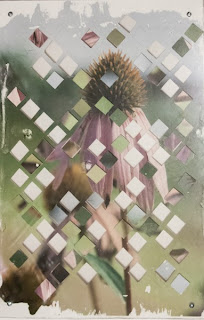This next one I labored over for such a long time! I feel in conveys the right mood and setting. I wonder about extremely long format. (I might rework it a little to shorten it. I haven't decided if that's entirely necessary.)
This last one is my most recent, and perhaps even the most interesting. I am really pleased where I got with it.
Julie was also very intrigued by this one. She suggested the crop I have here, with the top edge flush with the frame of the window ( We also talked about cropping the upper corners, which I plan to do in the final presentation.). She also suggested centering the carousel. There were a couple technical points I have to look at closer before the final prints, but that's the point of work prints--to see what needs adjusting. The nature of this style is that it requires a high degree of nitpicking. I enjoy it though. It satisfies a certain degree of obsessive compulsiveness I possess.
As we spoke, Julie asked about my interest in history. I lean heavily towards this specific historical architecture, and she wondered about the purpose of that. I know I find it interesting. So far, many of the buildings have been libraries or churches. It reminds me of the Age of Enlightenment, and these grand intentions our ancestors had. I wonder what they would think of these spaces now, often occupied by the homeless. The cathedrals, similarly built to convey the very presence of God, yet now are mostly empty, save the tourists. The ideals are gone, but the buildings remain.
We began to talk about history and historical references I seem to make in my work. It's interesting that these reference are still there. In my original body of work I brought into the program, I was very interested in places having layers of history we can't see. I think about time traveling in circles, where things seem to reoccur throughout history. The idea of myths came up in our discussion as well, and I mentioned my interest in anthropology during my BFA studies. Perhaps there is something worth pursuing in this.
I left the meeting feeling much more confident in my intentions and content from this series of work. I feel a surge of nerves in anticipation for the upcoming residency. It will be interesting to hear what sort of feedback I receive.


















































